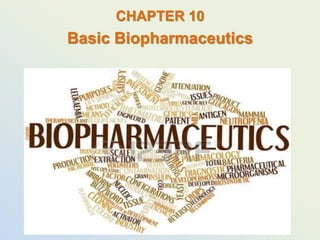
4556210.ppt
- 2. How Drugs Work • drugs produce either desired or undesired effects on the body • once in the blood, drugs are circulated throughout the body • the properties of both the drug and the body influence where the drug will go and what concentration it will have at its target site • the site where a drug causes an effect is the site of action • the objective of drug therapy is to deliver the right drug, in the right concentration, to the right site of action and at the right time to produce a desired effect
- 3. • when a drug produces an effect, it is interacting at a molecular level with cellular material or structure (receptor) • the receptor is described as a lock into which the drug molecule fits (key) and only those drugs able to bind chemically to the receptors at the site of action can produce an effect • this is why drugs are selective in their action – they only act on specific targeted receptors and tissues • receptors are located on the surfaces of cell membranes and inside the cells
- 4. • when drug molecules bind with a receptor, they can cause a reaction that stimulates or inhibits cellular function • the pharmacological effects of these interactions are termed agonism or antagonism agonists • drugs that activate receptors and produce cellular response that may either accelerate or slow normal cellular processes – depends on the type of receptor involved • for example: epinephrine-like drugs act on the heart to increase heart rate / acetylcholine-like drugs act on the heart to slow the heart rate antagonists • drugs that bind to receptors but do not activate them • they block the receptors’ action by preventing other drugs or substances from interacting with them
- 5. • the number of receptors available to interact with a drug will directly influence the effect • a minimum number of receptors have to be occupied by drug molecules to produce an effect – if too few there will be little to no effect • once all receptors are occupied, increasing the dose will not increase the effect • receptors can be changed by drug use • extended stimulation of cells with an agonist can reduce the number or sensitivity of the receptors – the effect of the drug is reduced • extended inhibition of cell functions with antagonists can increase the number or sensitivity of receptors - if the antagonist is stopped abruptly, the cells can have an extreme reaction – antagonist drugs are gradually discontinued to avoid withdrawal symptoms
- 6. drug action at the site of action • like a lock and key, only certain drugs are able to interact with certain receptors types of action • act through physical action – the protective effects of topical agents • react chemically – antacids that reduce excess gastric acidity • modify metabolic activity of pathogens – antibiotics • change osmolarity of blood and draw water out of tissue into the blood • incorporate into cellular material to interfere with normal cell function • join other chemicals to form a complex that is more easily excreted • modify the biochemical or metabolic process of the body’s cell or enzyme systems • some drugs work by changing the ability of ions to move into or out of cells (calcium and sodium channels allow movement of ions into nerve cells – stimulate function / potassium channels move ions our of nerve cells – obstruct function) • some drugs modify the creation, release or control of nerve cell hormones that regulate physiological responses
- 7. Concentration and Effect • it is difficult to measure the amount of a drug at the site of action and thus predict an effect • many factors influence a drug’s movement from site of administration to site of action – metabolism, excretion, membrane permeability, etc… • one way to monitor the amount of a drug in the body and its effect at the site of action is to use a dose-response curve • human variability: different people have different characteristics that affect how a drug product behaves in them
- 8. • a better way to relate the amount of drug in the body to its effect is to determine drug concentrations in body fluids • blood is usually used because there is rapid equilibrium between the site of administration and the site of action how used… • manufacturers use data to evaluate drug products • pharmacy professional evaluate compounding formulations • research measures human variability of drug products • physicians monitor drug therapy for patients